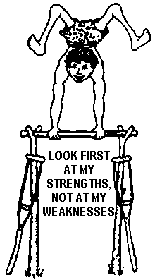Introduction to Part Five
People Helping and Learning
from Each Other as Equals

The importance of physical aids and equipment must not be undervalued.
They can be essential for some people to meet their full potential.
However, many disabled persons feel that the most difficult
barriers they face are not physical, but social. Non-disabled
people tend to see them as helpless and invalid (not valid). Too often
they focus on what disabled persons cannot do rather than on what they can
do, on their weaknesses, not their strengths. As a result, many persons
with disabilities are denied an equal chance.
To win more equal opportunities will require a community with greater
understanding, appreciation, and respect for all people, regardless of
differences. This necessitates changes in many people's attitudes and
perceptions. In the words of disabled activist Joshua Malinga from
Zimbabwe,
"IT IS SOCIETY THAT NEEDS TO BE REHABILITATED."
Soft Technologies. Some important innovations for the
enablement of disabled persons are in the realm of "soft" technologies.
They include methods, games, and activities for
building greater awareness, understanding, and equality with
those who are different. They foster a spirit of caring and sharing, of
looking at other people's strengths, not their weaknesses.


In this part of the book, we look at examples of soft technologies that
help to engender appreciation and equality. But in reality, there is no
sharp division between "hard" technologies (which deal with things) and
"soft" technologies (methods, approaches, and human processes). The
earlier parts of the book stressed the importance of equality and
partnership in developing technical aids that meet disabled persons' needs
on their terms. By contrast, here we see that some of the best ways for
disabled persons to win respect and acceptance in the community are
through the development of practical skills and by taking
action to assist or defend the rights of others. Actions
speak louder than words.
In the village of Ajoya where PROJIMO is located, the community's
growing appreciation of disabled persons has not primarily been due to
awareness-raising campaigns.
Rather, attitudes have changed as people have witnessed, in their daily
lives, the skills which disabled people have gained and the crucial
services they provide.
The fact that both the disability program and the health
program are run mainly by disabled persons, and that the whole community
benefits, has done much to change people's views about what disabled
people can do. |